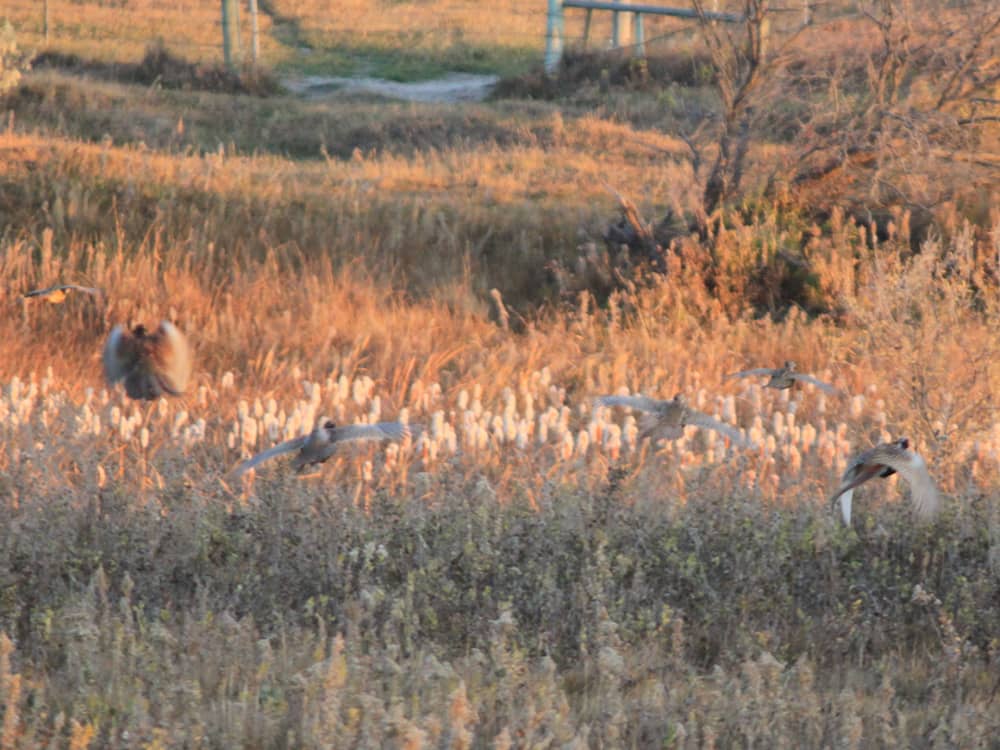
Pick One. Singling out a rooster in a group of flushing pheasants makes the shot easier and helps overcome the excitement of a large number getting up all at once. Simonson Photo.
By Nick Simonson
There is nothing more surprising on an upland hunt than to wander into a draw or to the edge of a stretch of grass and watch a covey of grouse or a group of pheasants rise en masse, wings whirring over their warning calls issued in the moment of excitement.
Likewise, there are few results more disappointing in the outdoors than to expend two or three shots after an adrenaline-fueled shouldering of a scattergun and come away empty handed from such an amazing opportunity. The phenomenon of flock shooting is often to blame for the misses, and the overwhelming nature of the moment leads to an overriding drive to just shoot at the group and not take a narrower perspective of things.
While it isn’t easy – I spent many years just blasting at the bunch before I began to take a more granular look at a flushing flock of birds – with experience and a few pointers, I’ve found better success when the group presents a chance to bag a rooster, sharpie or hun. Getting over the initial rush, focusing on a single bird, and the following up or finding a straggler are some of the best ways to convert a flock shot into a great retrieving opportunity for the dog.
Anything can happen in the outdoors, and it often does. But after a while, the seemingly irregular begins to take on a pattern. I’ve had flocks of partridge flush from the black dirt of a tilled wheat field and four roosters pop out of a willow thicket which would have made for a perfect outdoor post card. In both instances occurring in my early years in the field, I bagged exactly zero birds from each experience. However, they were formative in helping me go through the rush of a group flush, and more importantly, taming the surge of excitement that comes with it.
It can be overwhelming, especially when it comes without warning from the dog or environmental cues but knowing where birds are likely to relate due to weather or food sources or habitat can help prepare a hunter for such a flush. Windward ends of grass, the terminus of treelines, protected places on sunny hillsides and other classic grouse and pheasant holding spaces learned through experience will help provide expectations of when and where group flushes will occur. Being ready for the flush, whether it’s one or ten birds, is half the battle.
When a number of birds get up together, don’t get lost in the flock. Single out a specific bird and stay on it. This is easier with pheasants because it comes down to picking a brightly-colored rooster from the beige hens which might be flying around him. With sharptailed grouse and Hungarian partridge, it may be harder, as both genders are fairly uniform in their colorations. Sometimes one sharpie in the covey may present a better view of its white belly, or one may take off later than the rest of the group, and the male Huns have a slight orange hue to them. Simply single that unique bird out from the group and take the shot.
Alternatively, pick one at the leading edge of the flock, or the top, and stay on it. The human eye-to-brain connection is amazing at picking out slight differences in a homogeneous setting and honing in on those unique markers, even in moments of excitement.
After that first bird goes down, and if the flock presents another opportunity, repeat the process of picking out the next target, likely one near the back of the group which is closer. Don’t rush the shot with the idea the salvo of pellets won’t catch up, because they will, especially if utilizing a second barrel with a slightly tighter choke. Alternatively, note that some birds may linger on the ground behind the flock, or may be positioned off to the side of the main group. Especially with pheasants, let the dog work cattails, brush or other habitat near to where the main birds got up to get any stragglers into the air.
It’s likely that another opportunity awaits. Even with grouse, there may be a singleton or pair nearby that will provide another shot without all the whir of wings which produced the elevated heart rate from the group that went ahead of them. If a shot remains in the backup barrel or the tube, get ready to use it, or quickly reload to be ready.
The flock shooting experience is one that every uplander experiences, and often leaves us scratching our heads when we have nothing to show for what seems like a golden opportunity.
Through time in the field and knowledge of where these group flushes are most likely to happen, focusing in on a single bird rather than the bunch, and knowing where secondary opportunities may be in those thrilling moments can make them more productive, providing a memorable conclusion to an exciting occurrence…in our outdoors.
